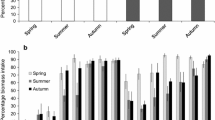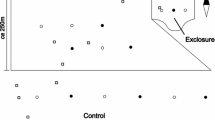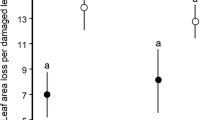Abstract
Forests on the Haida Gwaii (HG) archipelago (British Columbia, Canada) evolved for about 10,000 years in the absence of large-mammal browsing. The introduction of black-tailed deer (Odocoileus hemionus sitkensis) from the mainland prior to 1901 provides an opportunity to evaluate changes in the adaptive defensive responses of plants to herbivory. We compared (1) food choice by deer and (2) chemical defence (terpene concentrations) between HG and mainland red cedars (Thuja plicata) using (1) nursery-grown seedlings never exposed to deer, (2) branches from trees that grew before the introduction of deer ("old trees") and (3) saplings exposed to deer herbivory on the mainland and on HG. We used the first two plant categories to test the hypothesis that plants that evolve under low herbivory levels have lower anti-herbivore defences. We used saplings to study the consequences of the dramatic increase in browsing on HG. During food experiments, deer preferred HG seedlings and old tree branches compared to those from the mainland. Total monoterpene concentrations were much higher than diterpene concentrations in all plant categories. Within plant categories, multivariate analysis showed that terpene profiles differed significantly between HG and mainland red cedars: HG seedlings and old trees had lower monoterpene levels. These results suggest that some monoterpenes may be determinants of deer food choice and that the defences of HG plants are less effective than those of mainland plants. The deer used branches from HG and mainland saplings indiscriminately. However, terpene profiles differed significantly between HG and mainland saplings, with multivariate analysis suggesting a higher defensive response in browsed HG saplings. Monoterpene profiles were different in lightly and heavily browsed saplings from HG, suggesting that under the current browsing regime, individuals with the greatest constitutive defences, or with greatest potential for induced defences, grow better and are selected on HG.
Similar content being viewed by others
Author information
Authors and Affiliations
Additional information
Electronic Publication
Rights and permissions
About this article
Cite this article
Vourc'h, G., Martin, JL., Duncan, P. et al. Defensive adaptations of Thuja plicata to ungulate browsing: a comparative study between mainland and island populations. Oecologia 126, 84–93 (2001). https://doi.org/10.1007/s004420000491
Received:
Accepted:
Published:
Issue Date:
DOI: https://doi.org/10.1007/s004420000491




